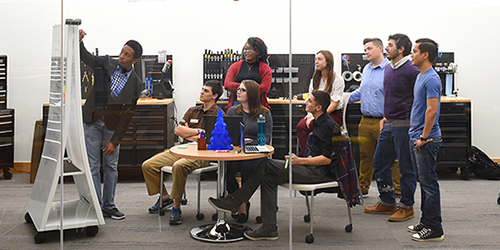Creating community: Breaking institutional barriers to attain diversity, equity and inclusion
Creating community: Breaking institutional barriers to attain diversity, equity and inclusion

In working to build a welcoming and inclusive community for everyone on its campuses, Rowan University first made a painful realization. Wishful thinking wasn’t enough.
As an Iranian immigrant, Rowan President Ali Houshmand himself experienced bigotry while in college in England and here in the United States. As president, he had an opportunity to influence change.
“We should not even have to have a conversation about equity and inclusion for everyone but the fact remains that people are not always inclusive,” Houshmand said. “Whether unintentional or intentional, people are sometimes not necessarily welcoming to people of color, or to people of a sexual orientation, country of origin, ability, who speak a different language, or religion that differs from their own. We needed to make a big change.”
While the rapidly growing public research university had long pursued initiatives to increase the diversity and inclusion of its student body and staff, those efforts were noteworthy but disparate. Houshmand decided bold action was necessary.
First, he appointed a president’s fellow for diversity and inclusion to identify issues and help address diversity and equity concerns. In only a year, it was clear that, while people in key departments across the University were well-intentioned and showed commitment toward the work, institutional structures made it difficult for real growth.
To plow through those barriers, Rowan became the first university in New Jersey and one of perhaps just a few in the nation to create an entire division—grouping departments from across the institution—working toward that end, including staff and faculty professional development. Creating a safe and welcoming environment for historically marginalized populations and people of all abilities became an institutional priority.
And it’s already making a difference.
Taking action
Founded in 2019, Rowan’s Division of Diversity, Equity & Inclusion is charged with a mission of universal acceptance, of promoting inclusion and belonging regardless of ability, race, gender, sexuality, age, faith, national origin or political perspective.
“Our belief in developing Rowan as a place of acceptance and diversity goes well beyond a clichéd perception that this is just about race,” said Dr. Monika Williams Shealey, the division’s senior vice president. “We’re focused on every student, faculty member and staff member on campus, every one of whom wants to be valued for who they are, without having to worry about identity being an issue.”
Data collected during an extensive listening tour during the division’s earliest days revealed disparities in graduation rates, student debt load, enrollment trends and interactions with police.
From the start, it was clear. The division would need to address ingrained attitudes about race, changing demographics, current events, even the evolving nature of social media. Change would only come with the involvement of every University department and office, from facilities and academics to human resources and procurement.
“For far too long, the work of DEI has fallen on marginalized populations to explain it or create opportunities,” said Dr. Penny McPherson-Myers, the division’s vice president. “DEI is everyone’s responsibility because it impacts us all.”
First steps
The division created a DEI Council with more than 40 representatives from across the University to meet monthly. In its first year, the division launched a monthly blog to share activities, goals and progress; restructured the Title IX Office to address additional bias and harassment claims, created a DEI certificate program, developed unconscious bias training and launched its Neurodiversity Task Force to ensure that students and staff with neurological differences are recognized and supported. And most importantly, every department across the University adopted DEI-related annual goals.
In June 2020, the division was already well-primed to develop a five-part series of public discussions in answer to the national turmoil following the May 25 killing of George Floyd by police. The moment was ripe. More than 600 people participated.
The public hungered for more. Today, the DEI certificate course quickly fills up each time it’s offered. The division now offers professional development courses for business and industry, as well as to other institutions. A book study group challenges participants to think deeply about anti-racism each semester.
The Division of DEI’s work is not just for students—it’s with them. In 2020, in observance of Juneteenth, University administrators and employees marched alongside students to protest racism in law enforcement and to celebrate the end of slavery. Students also serve on the DEI Council and even those who have graduated remain connected to the University, offering feedback and support.
As an educator, Shealey believes in the power of education to transform hearts and minds. She’s encouraged by the University’s direction and the community’s readiness to learn.
“South Jersey is reflective of our entire country,” Shealey said. “I have seen racism up close and personal. Yes, we’ve come a long way in this country, but until we address the roots of our issues—particularly as it relates to race, class and gender—we are continuing to put on Band-Aids. With this division, we’re not just addressing the symptoms. We’re addressing the root causes.”
To learn more about Rowan University’s Division of Diversity, Equity & Inclusion, visit the DEI blog at https://rowandei.wordpress.com/